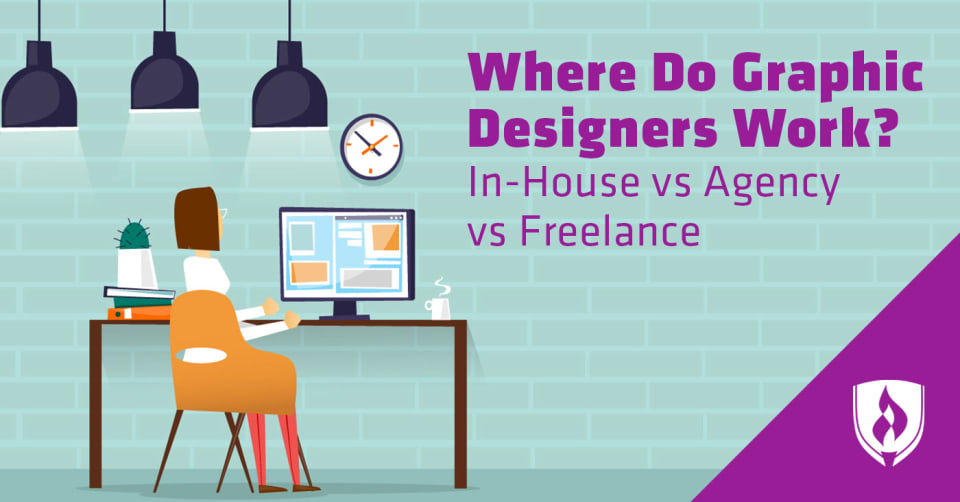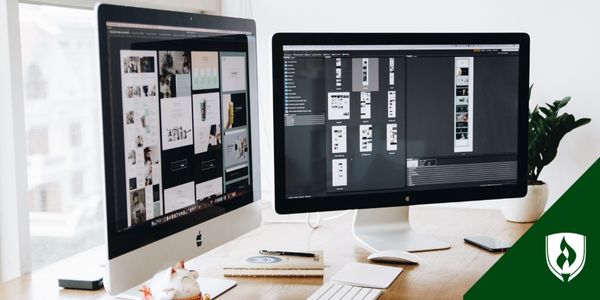
Your creative thinking, technical prowess and artistic passion make you the perfect candidate for a career in graphic design. It’s always been in the back of your mind, but somewhere along the way, the real world rudely interrupted your dreams. You became an adult with bills, responsibilities and possibly even people who depend on you.
But graphic design is just as practical as any other career choice if you have the right mindset and work ethic. The fact that you’re doing a little research before making a commitment is a good start.
First thing’s first: Where do graphic designers work? And how does the work environment impact the daily job? There are a variety of options. From working in-house to an agency to your own home, you’ll find the perfect work environment to cultivate your creativity.
This resource will help you understand your options. We asked graphic design pros for a behind-the-scenes look at each of these work environments. Hear what the experts have to say about each opportunity.
Working as an in-house graphic designer
Working in-house refers to being employed with an established organization or brand. You would likely be part of a small team of designers or possibly even the only one. In-house designers tend to be generalists, possessing a broad range of general design skills in order to meet all the creative needs of the company.
“Working in-house for one company allows you to grow and explore an in-depth understanding of one brand and its goals in a way that agency work could never allow you to do,” says Becky Putnam, Graphic Designer at seoplus+. “In my experience, you basically get the chance to build something with more of a long-term strategy in mind.”
Advantages of working as an in-house graphic designer:
Perks of a traditional work environment
“I love separating home and work, seeing my coworkers and being challenged by projects I’m handed,” says Miriam Housley, Graphic Designer for Sewell Direct. “I can get time off whenever I need; I have great benefits and a fantastic boss.”
A steady paycheck
Many of Housley’s fellow graduates set out to become freelance graphic designers, but she says the potential instability of that route was a deterrent for her.
“I realized I wanted to have a steady paycheck right off the bat, without having to build up a clientele,” she explains.
Opportunity for advancement
“Working in corporate can have a lot of benefits ranging from gaining experience quickly and having the ability to learn under a senior designer,” says Megan Vaughan, Owner and Designer of Prolific Banana.
Vaughan says this environment lends itself to designers climbing the career ladder. “There are many opportunities for advancement if you're willing to put in the work,” she adds.
One brand to develop
Unlike other design roles, an in-house graphic designer will almost always work on projects connected to a single brand, according to Rachel Ketterer, junior interactive designer at eCity Interactive.
“This allows designers to get to know the ins and outs of the organization’s brand, style guide and their target audiences,” she says. It also allows you a better opportunity to see the fruits of your labor and build upon the work you’ve done in the past.
Disadvantages of working as an in-house graphic designer:
More rules
The company’s brand can be a great way to develop and fine-tune your abilities, but it can also feel restrictive, according to Erin Morris, Founder and Designer of Evergreen Design Studio. You’ll need to come up with new ideas while adhering to brand guidelines.
Additionally, Vaughan points out that you will need to do whatever projects you are assigned to in an in-house environment—whether you like them or not.
“In the corporate world, there will not be room to refuse,” Vaughan says. “Doing so can easily jeopardize your career.”
More communication
“You'll find yourself having to explain in greater detail justification for why the design looks like it does,” Morris says. She explains that there is typically a committee of non-designers responsible for approving or rejecting your designs. “You might find that one of the reasons a design gets rejected is that someone personally doesn't like the color brown,” she says.
A non-design environment
Working as an in-house designer most likely means working in an office space alongside non-designers. Randi Sparkman, Owner and Designer of Gold Leaf Digital, says an in-house environment might not be optimized with the designers in mind. It could be loud or distracting, and there will likely be fewer, if any, fellow designers to collaborate with.
You're cut out to work in-house if...
“If you enjoy being the creative mind behind a brand’s messaging, this might be the path for you,” Putnam says. Sparkman adds that an in-house position is often the most stable career option available for graphic designers, so anyone who’s in need of job security and a stable salary will probably prefer this environment.
Working as an agency graphic designer
Graphic design agencies are hired by outside clients to produce creative work, which means the designers work with an assortment of brands. Agencies usually employ several graphic designers who specialize in different areas in order to staff the various projects they are contracted to do. Accounts tend to be short-term and limited to a specific campaign.
“I enjoy the agency setting because it provides an environment that allows me to get creative with a variety of clients from all sorts of industries (and of all sorts of different business sizes),” Putnam says. “I’m practically pitching my ideas and creative skills to these different clients on every project.”
Advantages of working as an agency graphic designer
The expectation of design excellence
In an agency, your managers and co-workers are very familiar with the world of design and are likely designers themselves. The expectations for your professionalism and abilities will be high, according to Morris. This benefits your design skills and can streamline the project, as agencies won’t have as many communication delays or misunderstandings from non-design coworkers.
Mentors
Morris says agencies tend to have experienced designers who can be excellent mentors for new designers. Agencies tend to have their processes established and streamlined, and new designers can glean valuable experience from the more established professionals.
“Hands down—an agency is the best place to learn more about being a designer,” says Ed Bebee of Iron Strikes Iron. “You get to see what other designers are working on, how they work and get exposed to their influences.”
Focus on graphic design
Freelancers wear many hats to keep themselves in business and in-house designers may wind up taking on non-design tasks depending on the needs of their company. But in an agency, you can almost guarantee that your daily work will be well within the realm of graphic design.
“You'll be working around copy editors and creative directors, so the role of graphic designer is very well defined,” Morris says. “You won't be expected to take on other duties.”
Disadvantages of working as an agency graphic designer
Less job security
Since agencies live on projects from numerous clients, there is a risk of needing to cut graphic designers if the project list dips too low.
“Agencies hire staff to match the contracts they have,” Bebee explains. “If one of their clients hires a different agency, your job goes to that agency and you could be laid off.”
Rigorous hours
Agency settings are typically fast-paced and odds are you’ll have plenty of work on your plate.
“With an agency, a graphic designer will be expected to work many hours with tight deadlines,” Morris adds. This might include working an occasional late night to finish a project or regularly logging extra hours.
You're cut out to work at an agency if...
If you love diversity in your projects and don’t mind spinning a few plates at once, agency work could be perfect for you.
“In the morning I might be brainstorming a landing page design concept for a local landscaping company, and in the afternoon I’ll be designing an ad campaign for an international clothing company,” Putnam says. “The diversity of projects keeps me inspired and motivated every day.”
Working as a freelance graphic designer
Freelance graphic designers are self-employed. They are responsible for every aspect of their business, from marketing and client relations to bookkeeping and invoicing. This means freelance designers must possess more than just design skills.
“Freelance is a whole different ballgame,” Morris says. “You really need to be self-disciplined enough to create and stick to a schedule.” She explains that a tremendous amount of time will have to be spent marketing yourself and handling the administrative tasks that come with managing a business.
Advantages
Location
Don’t fancy a commute? No problem. Need to get out of the house? That’s doable too!
“The major pro here is that this job can be location independent,” Morris says.
If you like to travel around or if you live in a remote location—or even if you just hope to never set eyes on traffic again, the flexibility to earn your living from anywhere with Wi-Fi is hard to beat.
More creative freedom
“I get to select the work that I feel would challenge me and inspire me the most and be worth my time,” Putnam explains. “That creative freedom is great.”
Freelancers have the freedom—at least in theory—to turn down any contract or project that doesn’t sound worthwhile. However, Putnam cautions freelancers to maintain a reliable client base if you want to survive. The need to keep work coming in might mean you can’t be very choosy – at least in the early stages of your business.
A tailored schedule
Who says a workweek needs to be one-size-fits-all? As a freelancer, you can tailor your hours to the lifestyle you want, as long as you keep up your productivity and workload.
“You have more control over your time in freelance,” Bebee says. “My week’s hours are the same as if I worked 9–5, but I can shift things around to optimize my time.” He offers the example of his designer friend who is a serious cyclist. His daytime hours are spent training, and he works his design business during late afternoons and evenings.
Disadvantages
No coworkers
While you might certainly take on work that requires communication with the client or even other designers, you’ll be working alone for the most part, according to Bebee. People who thrive in collaborative environments might find this isolation uninspiring. This can also be a challenge for those who rely on co-workers to stay motivated, as they will definitely need to come up with a new strategy for accountability.
Hunting and bidding for work
This is a pretty significant downside to the freelancing world. Instead of sitting back, waiting for projects to land on your desk, you’ll need to go out and be actively seeking new opportunities. You may even find yourself competing with others to win projects, according to Bebee.
Unreliable pay without benefits
“The pay can vary wildly from month-to-month, especially at first,” Morris says.
Even when you are more experienced and working with multiple clients, low months can still happen.
You’ll also be responsible for your own health insurance. “You’ll need to say goodbye to benefits like paid-time off, maternity leave and company retirement accounts,” Morris explains. “Arranging these things for yourself can also be time-consuming.”
You're cut out to be a freelancer if …
If you don’t stress too much about money—and maybe have some strong budgeting habits—freelancing could be a good fit. Creative flexibility matters as well as financial flexibility here. Sparkman says the timing for projects can vary widely depending on the client, and you still need to finish the job on time.
Along with that, “being self-motivated is a key requirement of freelance,” Bebee says. If you consider yourself business savvy and can keep pursuing new clients and improving in your ability, freelancing might suit you.
Design your own future
Whether you prefer the structure and security of the corporate world, the creativity and collaboration of agency life or the freedom and flexibility of freelancing, there’s a place for you in the world of graphic design.
So where do graphic designers work? The answer is everywhere—the key is finding the perfect work setting for you to flourish.
RELATED ARTICLES:




